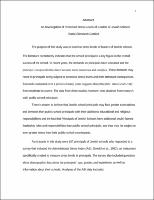Please use this identifier to cite or link to this item:
https://hdl.handle.net/20.500.12202/6736| Title: | An investigation of perceived stress levels of leaders of Jewish schools. |
| Authors: | Pelcovitz, David Shawn, Karen Schiffman, Mark Gottlieb, Elimelech Martin |
| Keywords: | Educational administration Educational leadership Jewish leaders stress school |
| Issue Date: | Jul-2020 |
| Citation: | Gottlieb, E. (2020, July). An investigation of perceived stress levels of leaders of Jewish schools. (Publication No. 28419516) [Doctoral dissertation, Yeshiva University]. PQDT |
| Abstract: | The purpose of this study was to examine stress levels of leaders of Jewish schools._______ The literature consistently indicates that the school principal is a key figure in the overall success of the school. In recent years, the demands on principals have increased and the principal’s responsibilities have become more numerous and complex. These demands may result in principals being subject to excessive stress levels and their attendant consequences. Research conducted over a period of many years suggests that principals’ stress levels vary from moderate to severe. The data from these studies, however, was obtained from research with public school principals.______ There is reason to believe that Jewish school principals may face greater expectations and demands than public school principals with their additional educational and religious responsibilities and the fact that Principals of Jewish Schools have additional, multi-faceted leadership roles and responsibilities than public school principals, and thus may be subject to even greater stress than their public-school counterparts._____ Participants in this study were 187 principals of Jewish schools who responded to a survey that included the Administrator Stress Index (ASI; Gmelch et al., 1982), an instrument specifically created to measure stress levels in principals. The survey also included questions about demographic data about the principals’ age, gender, and experience, as well as information about their schools. Analyses of the ASI data included: _____ (a) comparisons between the present study participant scores and previously published data on public school principals; (b) between-group comparisons between male and female leaders in the present study; (c) associations with potential conflict between levels of religiosity of leaders in the present study and their perceptions of their constituents’ level of religiosity; and (d) associations with the nature of school board involvement for participants in the present study. _____ Results indicated that Jewish school principals had lower stress levels relative to the public-school principals in the comparison data. In the discussion section, I offer several reasons for this finding, including the possibility that leaders of Jewish schools benefit from appraisal and coping techniques associated with religious practice and belief. Several of the a priori hypotheses for the predictive value of demographic variables in understanding Jewish school principals stress levels were supported, and in the discussion section I considered the pattern of results that emerged. |
| Description: | Doctoral dissertation, EdD / Open Access |
| URI: | https://hdl.handle.net/20.500.12202/6736 https://ezproxy.yu.edu/login?url=https://www.proquest.com/dissertations-theses/investigation-perceived-stress-levels-leaders/docview/2525704605/se-2?accountid=15178 |
| Appears in Collections: | Azrieli Graduate School of Jewish Education & Administration: Doctoral Dissertations |
Files in This Item:
| File | Description | Size | Format | |
|---|---|---|---|---|
| Martin Gottlieb EdD 2021.pdf | 876.63 kB | Adobe PDF |  View/Open |
This item is licensed under a Creative Commons License

